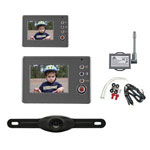How to Buy a Wireless Backup Camera for Your Car
When we got our Honda Pilot before our daughter was born one of the primary features we wanted was enough seating for eight people. While eight seats sound huge, the idea was to find enough room so that we wouldn't need two cars when various family members visit from out of state. What I hadn't counted on was how much I'd love having a backup camera to see behind the car when driving in reverse.
Several months earlier, I was backing out of a parking space in the Suzuki I've had almost as long as I've been writing tech articles. The parking lot had an odd slope to it and I couldn't see the car in a space behind me also backing out. We backed into each other. Thankfully at the rolling rate I was leaving the space, no one was injured. It sticks in my mind that the viewing area of the camera in our Honda Pilot would have prevented the minor collision because I could have seen everything in the blind spot created by the slope. I won't go so far as to say backing cameras should be a required safety feature in every car, but I do think many people can benefit. So what should you look for if you want to add an aftermarket backup camera to your car?

Backup camera kits for your car come in two varieties: wired or wireless. While there are many more choices in the wired camera market, I ruled out wired as an option because I didn't want to deal with finding a way to fasten in the wire and hide it throughout the car. Wireless is a viable alternative and makes installation simple. There are still factors to consider because you need a wireless backup camera that you can easily use.
Budget
Start out with how much you can afford to spend on your backup camera and work from there. Most rear-mounted car camera systems are under $200. You can find some workable solutions for under $130. The biggest variables for price our low light performance, screen size, camera mounting style, and viewing angle.
Low Light Illumination
While having any backup camera for your car improves visibility, low light situations are particularly important for seeing what's behind you. Most of the backup cameras have some form of night vision, but it's most important to look at the minimum illumination. Look for a camera that is rated for 0.5 Lux, which is about as close to operating in total darkness as you are going to get.
Viewing Angle
The viewing angle of your camera is another important aspect. You want to be able to see as close to the corners of your car as possible. I haven't seen a camera that goes wider than 140 degrees, which doesn't get you all the way to the corners, but should give you enough visibility to rely on your side mirrors to see right at the corners. Definitely steer clear of anything under 100 degrees visiblity because the wider viewing angle is much better for things like parallel parking in addition to seeing objects behind you.
Camera Mounting
Rear camera mounting is largely either a bolt-on or mounting to the license plate frame. License plate height seems to work well for most cars, but the mounting is really a personal preference.
Screen Mounting System
Screen mounting comes in one of three forms. You can either mount the screen to the top of your dash, mount to one of the air vents in the front of your dash, or use a screen that either sits over or replaces your rearview mirror. The built-in screen in our Honda Pilot is in the left corner of the review mirror. I find this to be an easy spot to look, but have also tested options that sit on the dash.
Screen Size
Screens seem to come in three sizes. You can either get 2.5-inch, 3.5-inch, or 7-inch screens. For dash mounting, 3.5-inch is probably the optimal size.
Final considerations
If you live somewhere with extreme temperatures, make sure the camera unit is rated to survive either the cold or heat. Some units offer an audio option, which isn't something I've ever needed, but might be a nice to have feature.